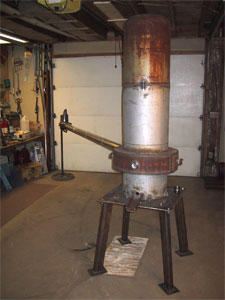Iron Work
When I began to think about making a working model of a stationary steam engine the material issue was that of material. Steam engines of the past were made of cast iron in huge foundries so, for authenticity, cast iron was the first choice. Some investigating turned up the surprising fact that there are enough steam model enthusiasts to generate a market for these specialized small iron castings. They are made and sold by a number of companies in several countries around the world. Because I wanted to make an original design and because they are rather expensive I didn’t seriously consider them.
 I decided to make the engine out of solid cast iron bar and rod stock. Machining the components of solid cast iron to make one engine was a practical alternative, so that is what I did. I used metal working machines to literally carve the parts for a steam engine. The base and the flywheel posed a problem because I couldn’t find iron stock that could be used. This problem was solved by a matter of luck when I gained access to the metal foundry at the University of Minnesota.
I decided to make the engine out of solid cast iron bar and rod stock. Machining the components of solid cast iron to make one engine was a practical alternative, so that is what I did. I used metal working machines to literally carve the parts for a steam engine. The base and the flywheel posed a problem because I couldn’t find iron stock that could be used. This problem was solved by a matter of luck when I gained access to the metal foundry at the University of Minnesota.
One thing leads to another and the experience in casting generated an interest in making my own iron castings. Some investigating turned up the surprising fact that there are several hobby iron foundries around the country with enthusiastic operators that freely share information in the form of published books, CDs, videos and impressive sites posted on the web.
In 2004 I started to build my own cupola. The refractory lining has been rammed and fired, finishing the cupola itself. Since then I have been able to collect all the necessary support items such as a pouring ladle and carrying shank, casting sand and frames, patterns and coke (the fuel), in addition to the necessary small pieces of scrap iron, the source of iron in the cupola’s diet. I have made a few practice wood patterns and even made a few practice sand molds but have not yet melted or poured any iron. Soon though. (As I write this in late 2010.)
Someday soon I will be able to cast simple replacement parts for antique engines and farm equipment, cast iron cookware, trivets and objects d art.
Two authors, my primary sources of information, need special notice here. My cupola is a modification of the design Steve Chastain describes in his book.
References for Small Cupolas:
- Iron Melting Cupola Furnaces for the Small Foundry, by Steve Chastain. Self published. Copyright 2000.
- Building small cupola furnaces, by Stewart Marshall. Self published. Copyright 1996.
- Building small cupola furnaces, the CD, by Stewart Marshall. Copyright 1999
Further References:
- Hot Metal (A Complete Guide to the Metalcasting of Sculpture), by Wayne Potratz, Turtle Sign Company. Copyright 1992.
- Melting Iron in the Cupola, by J.E. Hurst, republished by Lindsay Publications, 1993 from a volume first published by Penton Publishing Co. in 1929.
- Cupola Furnace, by Edward Kirk, republished by Lindsay Publications, 1998 from a volume first published by Henry Carey Baird & Co. in 1910.